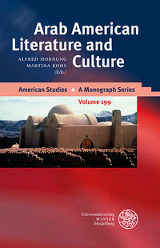Rezensiert von Simone Puff


The collection opens with a lawyer’s perspective that chronicles the daily hardships Arab Americans have been facing since the September 11 attacks, ranging from discrimination both at work and in daily life to racial profiling and hate crimes. Towards the end of his article, Ghada Quaisi Audi provides readers with a list of bias-free online resources on the diversity of Arab cultures and the Islamic world, which is particularly valuable for teachers and educators. The attention then turns to religion with an article on intercultural learning based on a classroom project in Germany that had four student groups work on different aspects of Muslim life in the U.S. In addition to describing the project, Rolf Theis also provides readers with practical commentary on “teaching aspects,” a list of useful sources, and four articles reprinted for in-class use regarding Muslim Americans.
Lisa Suhair Majaj’s contribution delineates the development of the past hundred years of Arab American literature, from the origins in the Mahjar school of Arab emigrant writers in the early twentieth century to more contemporary expressions of feminist Arab American writing and spoken word poetry. Rather than mere name dropping, Majaj engages in a superb and in-depth analysis of selected literary works and shows how changing social and political circumstances have influenced the development of the genre at large. Zou Lanfang and Yu Yuping follow with a short piece on selfhood in female life writing, taking My Life, the autobiography of the Egyptian feminist writer Nawal El-Saadawi, as their case study. Mita Banerjee puts the spotlight on Khaled Hosseini’s novel The Kite Runner, by making a compelling argument how Arab American literature offers counter-strategies to the often destructive stereotypes created in Hollywood. Her second article, co-written with Günther Sommerschuh, is a four-page essay on Arab characters in American film. Suggesting a “reading against the grain” (119), the authors offer a concise set of ideas how such characters can be used to deconstruct stereotypes and facilitate intercultural competence in German classrooms.
Moving away from the didactics of Arab American films, Heike Raphael-Hernandez performs a critical scholarly reading of seven mainstream and independent films that focus on the representations of Arab Americans after 9/11. One Hollywood production under scrutiny is the widely acclaimed film Crash, which – despite its progressive aims – falls short of a bias-free portrayal of the Persian immigrant shop owner (128-129). At the same time, Raphael-Hernandez’s article showcases important films that focus on non-stereotypical representations of Arab Americans which more closely resemble their lives after September 11. The independent movie American East, for example, serves as a reminder that post-9/11 stereotypes have led to what Nadine Naber calls “internment of the psyche” (137). Anneka Esch-van Kan introduces the reader to Arab American drama and the oeuvre of playwright Yussef El Guindi. By looking at some of his major plays she studies both the commonalities in terms of themes and motifs and the “evolution of his aesthetics” (153). The latter is aptly described by means of Russian dolls – a common metaphor in El Guindi’s plays – which Esch-van Kan sees as the defining metaphor for his plays’ aesthetics.
The focus of the collection turns from drama to dance as a theory and a “toolkit,” linking the fields of dance and literary analysis in an attempt to produce interdisciplinary theory (183). Silke Schmidt uses this fresh approach to explore Arab American women’s literature that is concerned with multi-ethnic identity negotiations. In a persuasive analysis of Diana Abu-Jaber’s novel Crescent and Laila Halaby’s West of the Jordan, Schmidt argues for dance choreography as a metaphor of identity development, particularly with regards to hyphenation and border crossings (210). This is followed by an essay by Birgit M. Bauridl, who establishes links between the works of poet Suheir Hammad and the autobiography of former professional lightweight rower Mark Gerban. As Bauridl illustrates, both Hammad and Gerban negotiate their forms of Palestinian and American identity through some form of “multiple consciousness” (222). Alex Lubin’s piece on hip hop music and spoken word poetry events links the lives of Haitian earthquake survivors, Hurricane Katrina victims, and Palestinian refugees. He sees the connection in what he calls “different configurations of colonial modernity” which produce “creative arts of geopolitical awareness” (261). At this point, the collection comes full circle with two articles that once again focus more on Arab American life rather than its literary expressions: This time with a more transnational and diasporic focus on the former inhabitants of a Syrian village who engaged in “kin-based chain migration” (277) to the U.S. and other countries (Anton Escher’s essay “Global Diaspora Sphere – the Arab Experience”), and the various cultural and architectural influences on mosque design in the U.S. (Omar Khalidi’s essay which is complemented by his own photographs).
Altogether, the essays in Arab American Literature and Culture take their readers on a fascinating journey of Arab American life and its myriad and complex expressions in literature and culture. The book stands out due to its transnational focus, which is enhanced by the articles that center on the subject of Arab Americans in German classrooms. Nevertheless, only three essays approach the topic from a specifically didactic angle, pointing out ways to include Arab American literature and film in the EFL classroom in German schools. As valuable as the more analytical scholarly contributions in the realms of literature and culture studies are, to see a few more practical approaches with which knowledge on Arab Americans can be brought into German classrooms would have enriched this outstanding book even more. But perhaps a sequel to this highly recommendable collection of articles in Arab American Studies is already in the making.
[1] These articles are written by Zou Lanfang and Yu Yuping, Heike Raphael-Hernandez, Silke Schmidt, Birgit M. Bauridl, and Alex Lubin.
Links:

